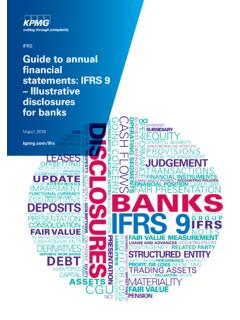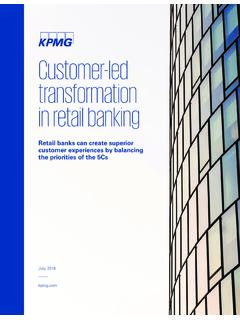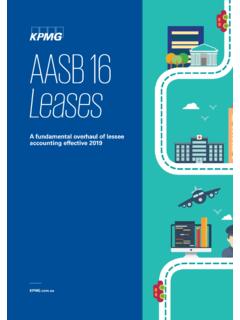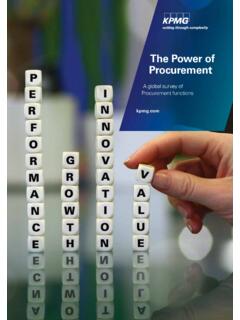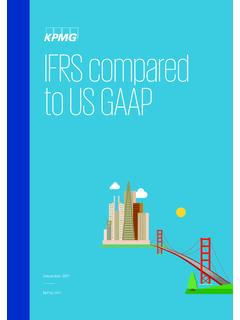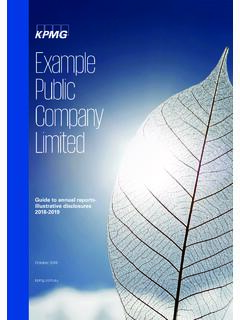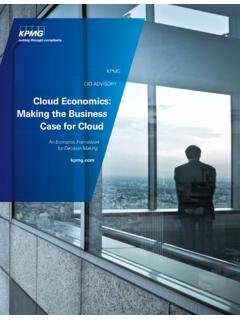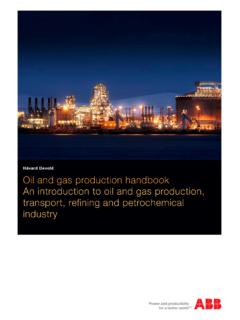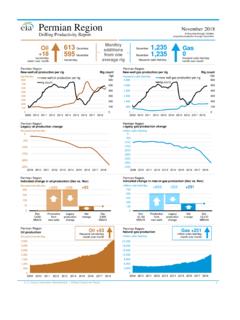Transcription of A Guide to Oil and Gas Taxation in Canada
1 A Guide to oil and gas Ta xa t i o n in CanadaKPMG in Canada | March 2015 | OF CONTENTS 4 Preface 5 Introduction 5 Canada s oil and gas industry 6 The tax environment 7 About this book 7 Glossary 7 Cross-references 7 Index 8 Overview of the Canadian tax regime 8 oil and gas activities 8 Forms of organization 9 Income Taxation 12 Capital gains 12 Utilization of losses 12 Tax administration 13 Filing requirements and tax payments 13 Corporations 13 Individuals 13 Trusts 13 Partnerships 14 Joint ventures 15 Functional currency tax reporting 16 Deductions, allowances, and credits 16 Canadian exploration expenses 17 Canadian development expenses 18 Canadian oil and gas property expenses 18 Foreign resource expenses 19 Successor corporation rules 19 Original owner 19 Successor 20 Predecessor owner 20 Expenses deductible to a predecessor owner and a successor 21 Amalgamations 21 Wind-ups 22 Structure allowing for a qualifying amalgamation of wholly owned subsidiaries 23 Acquisition of control 24 Capital cost allowance 24 Calculation of capital cost allowance 25 Flow-through shares 26 The look-back rule 27 Stacking arrangements 27 Use of a limited partnership 27 Dispositions of flow-through shares 27 Advantages
2 And limitations of flow-through shares 28 Investment tax credits 28 Scientific research and experimental development credit 29 Atlantic investment tax credit 29 Qualifying environmental trusts 30 Provincial credits and adjustments 30 Flow-through shares Qu bec 30 Ontario resource allowance adjustment 31 Structuring oil and gas investments 31 Corporate reorganizations 32 Tax-deferred transfers 32 Amalgamations 32 Wind-ups of subsidiaries 33 Acquisition of control 34 Partnerships and joint ventures 35 Income tax consequences 36 Advantages of partnerships 36 Farm-ins/farm-outs 37 Allocation of partnership expenses 38 Foreign operations 38 Operation through a branch 39 Operation through a foreign corporation 2015 KPMG LLP, a Canadian limited liability partnership and a member firm of the KPMG network of independent member firms affiliated with KPMG International Cooperative ( KPMG International ), a Swiss entity.
3 All rights in Canada A Guide to oil and gas Taxation in Canada2 39 Foreign affiliates 39 The foreign affiliate regime 40 The surplus rules 41 The upstream loan rules 41 The FAPI rules 44 Non-resident investors 44 Acquiring assets versus acquiring shares 45 Operating in Canada through a branch 45 Operating in Canada through a subsidiary 47 Provincial royalties and other taxes 47 British Columbia 47 Oil royalty 47 Natural gas royalty 48 Other oil and gas related levies/taxes 48 Alberta 48 Natural gas royalty 49 Conventional oil 49 Oil sands 50 Saskatchewan 50 Natural gas royalties 50 Oil royalties 52 Oil royalty programs 52 Manitoba 52 Natural gas royalties 52 Oil royalties 54 Manitoba drilling incentive program (MDIP)
4 54 Nova Scotia 54 Onshore oil and gas royalties 54 Offshore oil and gas royalties 55 Newfoundland 55 Onshore oil and gas royalties 55 Offshore natural gas royalties 55 Offshore oil royalties 55 Yukon 56 Northwest territories and Nunavut 56 Frontier land oil and gas royalties 56 Reserve land oil and gas royalties 56 Other provinces 57 Other taxes 57 Value-added and sales taxes 57 Federal 57 Provincial 58 Application to the oil & gas industry 60 British Columbia carbon tax 60 Cap and trade legislation 60 Carbon tax 61 Customs duties 61 Machinery and equipment 61 End use provisions 61 Temporary importations 61 Capital tax 61 Land transfer taxes 62 Glossary 62 Abbreviations 63 Tax terms 68 oil and gas terms 71 Appendix 72 Index 74 Acknowledgements 75 Energy industry insights 77 KPMG s energy tax practice 2015 KPMG LLP, a Canadian limited liability partnership and a member firm of the KPMG network of independent member firms affiliated with KPMG International Cooperative ( KPMG International ), a Swiss entity.
5 All rights in Canada A Guide to oil and gas Taxation in Canada3 Table of contentsTorran Jolly, CAPartner & General EditorBrian CarrRetired Partner & Deputy General EditorPREFACEOn May 14, 1914 in Turner Valley, Alberta, the famous Dingman Discovery Well spewed natural gas. This signified an important day for the Canadian oil and gas industry. Over the 100 years since this foundational event, the industry has seen considerable change. Commodity prices have been significantly volatile, energy markets have expanded, technology has improved, and oil sands have become commercially viable. In the process, the Canadian oil and gas industry has shifted from a domestic industry to an international energy consequence of this growth is that governments within Canada have increased the taxes levied on the industry. At the same time, they have taken measures to enforce environmentally and socially responsible development.
6 Faced with these challenges, oil and gas companies have remained committed to sustainable, economical, and responsible development of the book is intended for business professionals and for others with an interest in the oil and gas industry. It outlines the provisions of Canada s federal and provincial income tax legislation that are applicable to this industry, and it summarizes the provincial statutes that impose taxes and royalties on those engaged in the industry. It also describes other legislation that is relevant to oil and gas activities in trust that this book will be a helpful summary of the main features of Canada s current oil and gas tax regime. It should prove useful both to readers planning to undertake oil and gas exploration and development activities in Canada and to readers who wish to invest in Canadian energy entities.
7 We hope, too, that it will be a useful Guide to basic Taxation matters affecting the oil and gas who require further information or assistance are invited to contact any of KPMG s oil and gas professionals listed on page 77. 2015 KPMG LLP, a Canadian limited liability partnership and a member firm of the KPMG network of independent member firms affiliated with KPMG International Cooperative ( KPMG International ), a Swiss entity. All rights in Canada A Guide to oil and gas Taxation in Canada4 INTRODUCTIONCANADA S oil and gas INDUSTRYC anada s oil and gas industry is important to the nation s economic well-being. In 2013, exploration and production in this industry were ongoing in 12 of Canada s 13 provinces and territories. In 2012, the industry contributed approximately $18 billion in taxes and royalties to governments, and it employed 550,000 persons across is a leading producer of oil and gas worldwide.
8 In 2012, it was the third-largest producer of natural gas in the world and the sixth-largest producer of crude oil. Overall, it was the fifth-largest energy producer for that year. The demand for Canada s petroleum resources is expected to increase as existing reserves elsewhere in the world economies, such as those of China and India, are driving energy demands upwards, and economists believe this trend will continue, with a steady increase in oil consumption, until 2035. Despite increasing demand, the prices for petroleum products continue to factors contribute to fluctuations in oil and gas prices. These factors include the following: Variations in demand owing to seasonal weather changes. Demand is lower in the spring and fall. Additional travel in summer and cold weather in winter increase demand; in contrast, less travel and moderate temperatures reduce demand in spring and fall.
9 Weather conditions. Severe weather events, such as hurricanes, may damage oil and gas infrastructure. This limits supply and leads to higher prices. production and capacity levels. Higher inventory and production levels mean a greater supply and a reduction in prices. By the same token, lower inventory and production levels mean a reduced supply and increased prices. Technological improvements. Technological advancements in the industry lead to greater recoveries in areas of existing production , to discoveries in entirely new areas, and to extraction in areas where it was previously not viable. The general effect is increased production , which increases supply and reduces prices. Depletion of conventional sources. Global energy demands have depleted conventional oil and gas deposits, and this process is ongoing. As conventional oil and gas have become harder to find, unconventional methods of production , such as those from shale formations, have become more necessary.
10 Such methods are more expensive and lead to higher production costs. Political instability and conflict in various regions around the world. Energy demands and needs have historically contributed to various political issues. Some of these issues have resulted in political unrest and conflict. These factors normally result in an increase in commodity instability in petroleum commodity prices has contributed to volatility in the stock prices of Canadian petroleum producers. Despite this volatility, Canada s stable political climate, abundance of natural resources, and fluctuating petroleum commodity prices have resulted in an attractive environment for mergers and acquisitions in the oil and gas industry. 2015 KPMG LLP, a Canadian limited liability partnership and a member firm of the KPMG network of independent member firms affiliated with KPMG International Cooperative ( KPMG International ), a Swiss entity.
